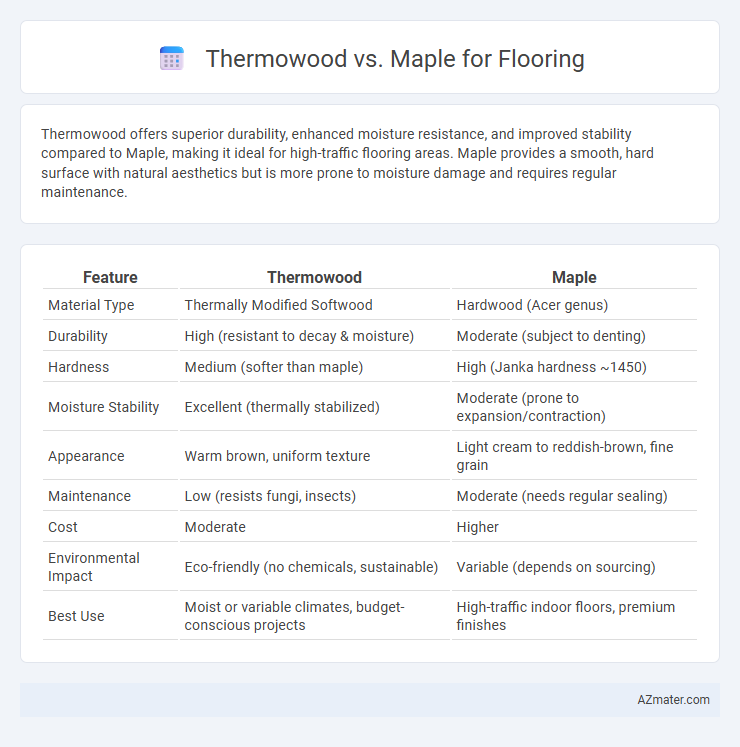Thermowood offers superior durability, enhanced moisture resistance, and improved stability compared to Maple, making it ideal for high-traffic flooring areas. Maple provides a smooth, hard surface with natural aesthetics but is more prone to moisture damage and requires regular maintenance.
Table of Comparison
| Feature | Thermowood | Maple |
|---|---|---|
| Material Type | Thermally Modified Softwood | Hardwood (Acer genus) |
| Durability | High (resistant to decay & moisture) | Moderate (subject to denting) |
| Hardness | Medium (softer than maple) | High (Janka hardness ~1450) |
| Moisture Stability | Excellent (thermally stabilized) | Moderate (prone to expansion/contraction) |
| Appearance | Warm brown, uniform texture | Light cream to reddish-brown, fine grain |
| Maintenance | Low (resists fungi, insects) | Moderate (needs regular sealing) |
| Cost | Moderate | Higher |
| Environmental Impact | Eco-friendly (no chemicals, sustainable) | Variable (depends on sourcing) |
| Best Use | Moist or variable climates, budget-conscious projects | High-traffic indoor floors, premium finishes |
Introduction to Thermowood and Maple Flooring
Thermowood flooring, produced by heat-treating timber such as pine or spruce at high temperatures, offers enhanced durability, dimensional stability, and resistance to moisture and decay compared to untreated wood. Maple flooring, valued for its dense grain and hardness rating of 1450 on the Janka scale, provides a smooth, durable surface ideal for high-traffic areas. While Thermowood delivers improved weather resistance and sustainability through thermal modification, maple ensures classic aesthetics and resilience, making both options popular choices depending on environmental conditions and design preferences.
Key Characteristics of Thermowood
Thermowood flooring boasts enhanced durability and dimensional stability due to its heat-treated process, which reduces moisture content and increases resistance to decay and insects. This modification gives Thermowood superior thermal insulation properties and improved surface hardness compared to untreated woods like Maple. While Maple offers natural beauty and hardness, Thermowood provides a more sustainable option with greater resistance to outdoor elements and moisture fluctuations.
Key Characteristics of Maple Flooring
Maple flooring is renowned for its durability and fine, consistent grain, making it ideal for high-traffic areas and contemporary designs. Its natural light color ranges from creamy white to light reddish-brown, offering versatility in interior decor and excellent stain absorption for customized finishes. The hardness of maple, with a Janka rating of around 1450, provides superior resistance to scratches and dents compared to softer woods.
Durability Comparison
Thermowood flooring offers superior durability compared to Maple due to its enhanced resistance to moisture, decay, and insect damage resulting from the thermal modification process. Maple, while naturally hard and dense, is more susceptible to changes in humidity and prone to denting under heavy impact. Choosing Thermowood ensures a longer-lasting floor in environments with variable climate conditions, making it ideal for both indoor and semi-outdoor applications.
Aesthetic Differences
Thermowood flooring exhibits a rich, warm, and uniform appearance with deep brown and reddish hues resulting from its heat-treatment process, enhancing its natural wood grain and durability. Maple flooring offers a lighter, more natural tone with fine, subtle grain patterns that create a clean, contemporary look ideal for bright, modern interiors. The choice between Thermowood's rustic elegance and Maple's smooth, pale finish significantly impacts the visual ambiance and style of a space.
Resistance to Moisture and Humidity
Thermowood offers superior resistance to moisture and humidity compared to Maple due to its heat-treated process that stabilizes the wood fibers and reduces water absorption. Maple, a hardwood commonly used for flooring, tends to absorb more moisture, making it more susceptible to warping and swelling in humid environments. This makes Thermowood a better choice for spaces with high humidity or moisture exposure, ensuring longer-lasting durability and stability.
Environmental Impact and Sustainability
Thermowood flooring is produced through a heat treatment process that enhances wood durability without harmful chemicals, making it an environmentally friendly option with improved resistance to decay and reduced need for chemical preservatives. Maple flooring, while naturally hard and durable, typically requires more intensive processing and treatment, potentially increasing its environmental footprint. Thermowood's sustainable production methods and longer lifespan contribute to a lower ecological impact compared to traditional hardwoods like maple.
Maintenance and Longevity
Thermowood flooring offers superior resistance to moisture, pests, and decay compared to Maple, resulting in lower maintenance requirements and enhanced durability. Maple, a hardwood, requires regular sealing and can be prone to scratches and dents, necessitating more frequent upkeep to maintain its appearance. Thermowood's thermal modification process increases dimensional stability and lifespan, making it a longer-lasting option for flooring in varying environmental conditions.
Cost Considerations
Thermowood flooring typically costs more upfront than maple due to the specialized heat treatment process that enhances durability and resistance to moisture. Maple offers a more budget-friendly option with a lower initial price, but may require additional maintenance and refinishing over time, potentially increasing long-term expenses. When evaluating cost considerations, it's essential to balance Thermowood's higher installation price against maple's maintenance and lifespan factors for an accurate total investment comparison.
Final Verdict: Which is Better for Flooring?
Thermowood offers superior durability and resistance to moisture, making it an excellent choice for flooring in humid or high-traffic areas, while Maple provides a classic hardwood aesthetic with hardness suitable for residential spaces. Thermowood's eco-friendly thermal modification process enhances dimensional stability without chemical additives, whereas Maple's natural hardness and fine grain contribute to its timeless appeal and ease of refinishing. For long-lasting, stable flooring with minimal maintenance, Thermowood stands out, but for a traditional, elegant look with proven durability, Maple remains a strong contender.

Infographic: Thermowood vs Maple for Flooring
 azmater.com
azmater.com